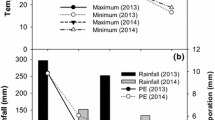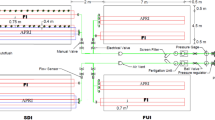Abstract
Drip irrigation and fertigation, being advocated for higher crop and water productivity require optimization of irrigation and fertilization schedules. Field experiments were conducted during 2016–2018 to evaluate water and energy-efficient drip irrigation and fertigation schedules for higher productivity and profitability from oilseed rape. The treatments comprised of a combination of three levels of drip irrigation {60, 80 and 100% of cumulative pan-evaporation (CPE)} and three levels of fertigation {60, 80 and 100% recommended dose of fertilizers (RDF)} along with one absolute control (flood irrigation and soil application of RDF). The yields of crop under drip irrigation at 100 and 80% of CPE were statistically similar but significantly higher than irrigation at 60% of CPE. The irrigation use efficiency (IUE) and water use efficiency (WUE) were maximum at 80% of CPE followed by 100 and 60% of CPE. Drip irrigation at 80% of CPE resulted in 18% higher yield along with a water-saving of 35.4% than absolute control. Energy use efficiency (EUE) was higher at 100% of CPE followed by 80 and 60% of CPE. Whereas, energy productivity at 100 and 80% of CPE being statistically similar but significantly higher than 60% of CPE. Highest benefit: cost (B:C) ratio and net returns were obtained with drip irrigation at 100% of CPE and lowest at 60% of CPE. Fertigation at 100 and 80% RDF recorded significantly higher seed yield than 60% RDF and absolute control.


Similar content being viewed by others
References
Abdelkhalik A, Pascual B, Najera I, Domene MA, Baixauli C, Pascual-Seva N (2020) Effects of deficit irrigation on the yield and irrigation water use efficiency of drip-irrigated sweet pepper (Capsicum annuum L.) under Mediterranean conditions. Irrig Sci. https://doi.org/10.1007/s00271-019-00655-1
Ahmad G, Jan A, Inamullah Arif M (2006) Phenology and physiology of canola as affected by nitrogen and sulfur fertilization. J Agron 5:555–562
Anonymous (2017) Area, production and productivity of Rapeseed and Mustard. http://nmoop.gov.in/ Statistics.aspx. Accessed 22 Jan 2019
Anonymous (2020) Package of practice for crops of Punjab, Rabi 2020–21. Punjab Agricultural University, Ludhiana, pp 20–31
Asad ME, Clemente SR, Gupta AD, LoofR HKG (2002) Impacts of fertigation via. sprinkler irrigation on nitrate leaching and corn yield in an acid-sulphate soil in Thailand. Agric Water Manag 52:197–213
Bodman GB (1942) Nomogran for rapid calculation of soil density, water content and total porosity relationship. J Am Soc Agron 34:883–893
Brar AS, Butter GS, Sharma R (2018) Water and energy productivity of rice as influenced by duration of cultivars, dates of transplanting and irrigation regime in north-western India. Paddy Water Environ 16:655–663
Chesnin L, Yien CH (1950) Turbidimetric methods of sulphate estimation. Proc Soil Sci Soc Am IS:149
Dastane NG (1967) A practical manual for water use research in agriculture. Navabharat Prakashan Publ Poona 4:50–58
DeClereq DR, Daun JK (1999) Quality of Western Canadian canola. Tech Rep Can Grain Commission, Winnipeg
Demircan V, Ekinci K, Keener MH, Akbolat D, Ekinci C (2006) Energy and economic analysis of sweet cherry production in Turkey: a case study from Isparata province. Energy Convers Manag 47:1761–1769
Enciso JM, Unruh BL, Henggeler JC, Multer WL (2002) Effect of row pattern and spacing on water use efficiency for subsurface drip irrigated cotton. Trans ASAE 45(5):1397–1403
FAOSTAT (2017) http://faostat.fao.org/ Accessed 6 Apr 2017
Howell TA (2001) Enhancing water use efficiency in Irrigated agriculture. Agronomy J 93:281–289
Jackson ML (1967) Soil chemical analysis. Prentice Hall of India Pvt. Ltd., New Delhi
Jeelani J, Katoch KK, Sandal SK (2017) Effect of drip fertigation levels on soil water dynamics, water use efficiency, yield and quality parameters of broccoli (Brassica oleracea L. var. italic) in wet temperate zone of Himachal Pradesh. Indian J Soil Conserv 45:96–104
Jha GK, Pal S, Mathur VC, Bisaria G, Anbukkan IP, Burman RR, Dubey SK (2012) Report on edible oilseeds supply and demand scenario in India: Implications for Policy Division of Agricultural Economics. Indian Agricultural Research Institute, New Delhi
Katyal JC, Singh B, Vlek PLG, Crasweel ET (1985) Fate and efficiency of nitrogenous fertilizers applied to wetland rice in Punjab. India Fertil Res 6:279–290
Kaur A, Brar AS (2016) Influence of mulching and irrigation scheduling on productivity and water use of turmeric (Curcuma longa L.) in north western India. Irrig Sci 34:261–269
Olsen SR, Cole CV, Watanabe FS, Dean LA (1954) Estimation of available phosphorous in soils by extraction with sodium bio-carbonate. USDA Circ 939:1–29
Piper CS (1966) Soil and plant analysis. Hans Publishers, Bombay
Qureshi AL, Gadehi MA, Mahessar AA, Memon NA, Soomro AG, Memon AH (2015) Effect of drip and furrow irrigation systems on sunflower yield and water use efficiency in dry area of Pakistan. Am-Eurasian J Agric Environ Sci 15:1947–1952
Rathod SS, Shekhawat K, Kandpal BK, Premi OP (2014a) Micro-irrigation and fertigation improves gas exchange, productivity traits and economics of Indian mustard (Brassica juncea L. Czernj and Cosson) under semi-arid conditions. Aust J Crop Sci 8:582–595
Rathod SS, Shekhawat K, Premi OP, Kandpal BK, Chauhan JS (2014b) Comparative effect of irrigation system and nitrogen fertigation on growth, productivity and water use efficiency of Indian mustard (Brassica juncea) under semi arid conditions of Rajasthan. Indian J Agron 59:112–114
Rathod SS, Shekhawat K, Kandpal BK, Premi OP (2017) Improvement of physiological and productivity traits of Indian mustard (Brassica juncea) through micro-irrigation and fertigation under hot semi-arid eco-region. Indian J Agric Sci 87(9):1257–1262
Reddy V, Immanuelraj K (2017) Area, production, yield and pattern of oilseeds growth in India. Econ Affairs 62:327–334
Sahoo P, Brar AS, Sharma S (2018) Effect of methods of irrigation and sulphur nutrition on seed yield, economic and bio-physical water productivity of two sunflower (Helianthus annuus L.) hybrids. Agric Water Manag 206:158–164
Sezen SM, Yazar A, Kapur B, Tekin S (2011) Comparison of drip and sprinkler irrigation strategies on sunflower seed and oil yield and quality under Mediterranean climate conditions. Agric Water Manag 98:1153–1161
Sinha I (2015) Performance of spring sunflower (Helianthus annuus L.) under different drip irrigation and fertigation schedules. M.Sc thesis, Punjab Agricultural University, Ludhiana.
Sinha I, Buttar GS, Brar AS (2017) Drip irrigation and fertigation improve economics, water and energy productivity of spring sunflower (Helianthus annuus L.) in Indian Punjab. Agric Water Manag 185:58–64
Subbiah BV, Asija GL (1956) A rapid procedure for the estimation of available nitrogen in soils. Curr Sci 25:259–268
Trifonov P, Lazarovitch N, Arye G (2017) Increasing water productivity in arid regions using low-discharge drip irrigation: a case study on potato growth. Irrig Sci. https://doi.org/10.1007/s00271-017-0538-8
Viets FG (1962) Fertilizers and the efficient use of water. Adv Agron 14:223–264
Wang D, Li G, Mo Y, Zhang D, Xu X, Wilkerson CJ, Hoogenboom G (2020) Evaluation of subsurface, mulched and non-mulched surface drip irrigation for maize production and economic benefits in northeast China. Irrig Sci. https://doi.org/10.1007/s00271-020-00692-1
Acknowledgements
The authors are highly thankful to Prof. S S Kukal for his critical suggestions and editing of the final manuscript. We are also grateful to the unknown reviewers for their valuable and insightful comments and suggestion.
Author information
Authors and Affiliations
Corresponding author
Additional information
Publisher's Note
Springer Nature remains neutral with regard to jurisdictional claims in published maps and institutional affiliations.
Rights and permissions
About this article
Cite this article
Kumar, D.S., Sharma, R. & Brar, A.S. Optimising drip irrigation and fertigation schedules for higher crop and water productivity of oilseed rape (Brassica napus L.). Irrig Sci 39, 535–548 (2021). https://doi.org/10.1007/s00271-020-00714-y
Received:
Accepted:
Published:
Issue Date:
DOI: https://doi.org/10.1007/s00271-020-00714-y




